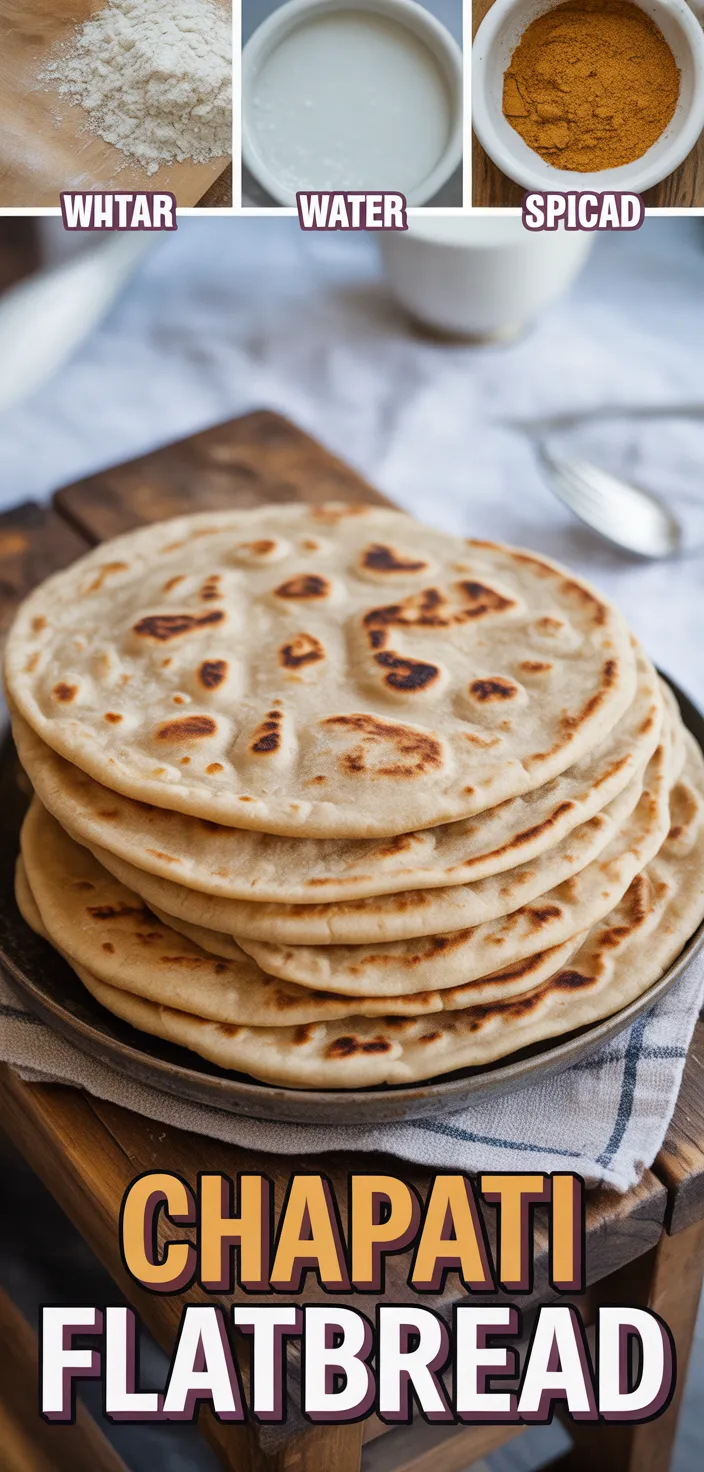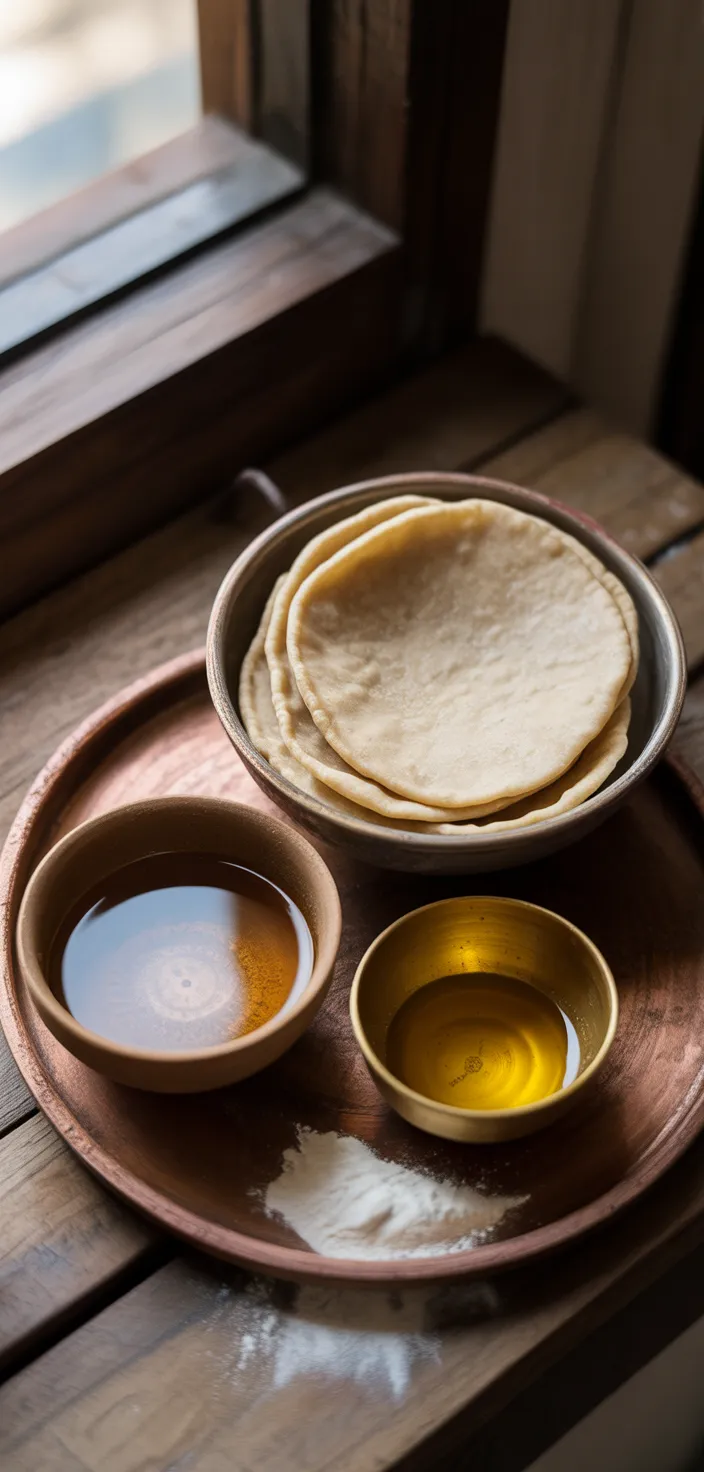I can’t wait to share my Quick Indian Flatbread, a three-ingredient chapati recipe rooted across India and East Africa that makes a global staple surprisingly simple.

I grew up watching my aunt press thin rounds from whole wheat flour (atta) with just lukewarm water, and that memory stuck with me. Chapati Flatbread feels simple but it hides tiny surprises, sometimes it puffs up like a little cloud other times it’s perfectly chewy.
I call it my go to when I want something honest and fast, a Roti Flatbread Recipe that doesn’t try to be fancy. As a Quick Indian Flatbread it’s humble yet stubbornly addictive, you’ll want to know why such plain bits of dough can be so satisfying even when they come out a bit lopsided.
Ingredients

Chapati is a simple, everyday flatbread from South Asia that fits into almost any meal.
It mainly uses whole wheat flour and water and with just a little practice you can roll and cook them fast.
Whole wheat brings fibre, protein and steady carbohydrates so you stay full longer, while water makes the dough soft and easy to work.
Salt is optional but brightens flavor, and a touch of oil or ghee makes the texture softer and richer.
Dusting with extra flour stops sticking, though too much will dry the bread out.
They are plain not sweet, very comforting.
- Whole wheat flour: high in fibre and complex carbs, gives nutty flavor and protein boost.
- Water: hydrates flour, forms dough, no calories, essential for soft pliable texture.
- Salt: optional, enhances savory notes and balances taste, use sparingly for low sodium.
- Oil or ghee: optional, adds fat for softness, richer mouthfeel and subtle buttery aroma.
- Extra flour for dusting: prevents sticking but excess dries chapatis and makes them dense.
Ingredient Quantities
- 2 cups (about 250 g) whole wheat flour (atta)
- 3/4 to 1 cup (180 to 240 ml) lukewarm water
- 1/2 teaspoon salt optional to taste
- 1 tablespoon oil or ghee optional for softer dough
- Extra whole wheat flour for dusting
How to Make this
1. In a large bowl mix 2 cups (about 250 g) whole wheat flour with 1/2 teaspoon salt if using, and 1 tablespoon oil or ghee if you want softer dough, use your fingers to combine.
2. Gradually add 3/4 to 1 cup lukewarm water, a little at a time, stirring until a shaggy dough forms; stop when it just comes together.
3. Turn the dough onto a lightly floured surface and knead for about 6 to 8 minutes until smooth and pliable, add tiny pinches of flour if too sticky, or a few drops of water if too dry.
4. Cover the dough with a damp cloth or plastic wrap and let it rest for 20 to 30 minutes so the flour hydrates and the gluten relaxes.
5. Divide the dough into 8 to 10 equal pieces, roll each into a smooth ball and keep them covered so they dont dry out.
6. Heat a cast iron or heavy nonstick skillet over medium high heat until very hot, test with a small scrap of dough or a drop of water it should sizzle on contact.
7. On a lightly dusted surface using extra whole wheat flour, roll a ball into a thin circle about 7 to 8 inches across, rotate while rolling to keep it round and dont use too much flour or the roti will get dry.
8. Cook the rolled chapati on the hot skillet about 20 to 30 seconds until tiny bubbles form, flip and cook the other side 20 to 30 seconds, press gently with a spatula or a clean cloth to encourage puffing, flip once more and cook until light brown spots appear.
9. Remove from the pan, brush with a little ghee or oil if you like, and keep wrapped in a clean towel or container to stay soft; repeat with remaining dough, adjusting heat as needed so they cook evenly.
Equipment Needed
1. Large mixing bowl for the dough
2. Measuring cups and spoons (or a kitchen scale for grams)
3. Wooden spoon or your fingers for mixing
4. Rolling pin and board or a lightly floured counter
5. Small bowl or ramekin for extra flour for dusting
6. Cast iron skillet or heavy nonstick pan (tava)
7. Spatula or tongs for flipping and gentle pressing
8. Bench scraper or knife to divide the dough into pieces
9. Clean kitchen towel or insulated container to keep the rotis soft
FAQ
Chapati Flatbread Recipe Substitutions and Variations
- Whole wheat flour (atta): swap with all purpose flour or try a 50/50 mix of whole wheat and all purpose for softer, lighter chapatis, they wont be as nutty. Spelt flour can work 1:1 but the dough is more delicate so use slightly less water.
- Water: use warm milk or unsweetened plant milk in the same amount for a richer, softer dough, or replace half the water with plain yogurt to tenderize the dough and make rolling easier.
- Oil or ghee: use a neutral vegetable oil like canola or sunflower, or melted butter for flavor. You can also knead in 1 tablespoon plain yogurt instead of added fat to keep the dough soft.
- Extra whole wheat flour for dusting: use all purpose flour for smoother rolling, fine semolina (rava) for a little crunch and less absorption, or rice flour to stop sticking without making the dough gummy.
Pro Tips
– Let the dough rest longer if you can, 30 to 60 minutes will hydrate the flour better and make the rotis softer, so dont skip this even if youre in a hurry.
– Keep your skillet really hot to start, then turn it down a little once the roti hits the pan so the inside cooks without burning the outside; test heat with a sprinkle of water or a tiny dough scrap.
– Use only a dusting of flour while rolling and keep the dough balls covered; too much flour makes them dry, and exposed balls will form a crust.
– After cooking, wrap the rotis in a clean cloth or airtight container right away so steam softens them, brush lightly with ghee or oil if you want richer flavor and longer softness.
Chapati Flatbread Recipe
My favorite Chapati Flatbread Recipe
Equipment Needed:
1. Large mixing bowl for the dough
2. Measuring cups and spoons (or a kitchen scale for grams)
3. Wooden spoon or your fingers for mixing
4. Rolling pin and board or a lightly floured counter
5. Small bowl or ramekin for extra flour for dusting
6. Cast iron skillet or heavy nonstick pan (tava)
7. Spatula or tongs for flipping and gentle pressing
8. Bench scraper or knife to divide the dough into pieces
9. Clean kitchen towel or insulated container to keep the rotis soft
Ingredients:
- 2 cups (about 250 g) whole wheat flour (atta)
- 3/4 to 1 cup (180 to 240 ml) lukewarm water
- 1/2 teaspoon salt optional to taste
- 1 tablespoon oil or ghee optional for softer dough
- Extra whole wheat flour for dusting
Instructions:
1. In a large bowl mix 2 cups (about 250 g) whole wheat flour with 1/2 teaspoon salt if using, and 1 tablespoon oil or ghee if you want softer dough, use your fingers to combine.
2. Gradually add 3/4 to 1 cup lukewarm water, a little at a time, stirring until a shaggy dough forms; stop when it just comes together.
3. Turn the dough onto a lightly floured surface and knead for about 6 to 8 minutes until smooth and pliable, add tiny pinches of flour if too sticky, or a few drops of water if too dry.
4. Cover the dough with a damp cloth or plastic wrap and let it rest for 20 to 30 minutes so the flour hydrates and the gluten relaxes.
5. Divide the dough into 8 to 10 equal pieces, roll each into a smooth ball and keep them covered so they dont dry out.
6. Heat a cast iron or heavy nonstick skillet over medium high heat until very hot, test with a small scrap of dough or a drop of water it should sizzle on contact.
7. On a lightly dusted surface using extra whole wheat flour, roll a ball into a thin circle about 7 to 8 inches across, rotate while rolling to keep it round and dont use too much flour or the roti will get dry.
8. Cook the rolled chapati on the hot skillet about 20 to 30 seconds until tiny bubbles form, flip and cook the other side 20 to 30 seconds, press gently with a spatula or a clean cloth to encourage puffing, flip once more and cook until light brown spots appear.
9. Remove from the pan, brush with a little ghee or oil if you like, and keep wrapped in a clean towel or container to stay soft; repeat with remaining dough, adjusting heat as needed so they cook evenly.















